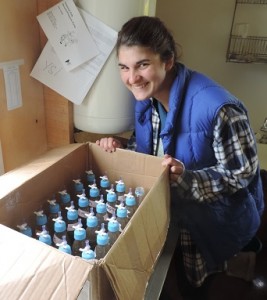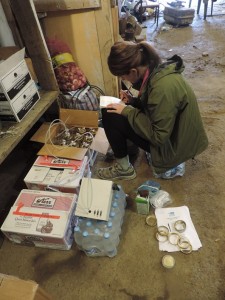
A classic example of science here in Siberia: water bottles improvised to incubate and measure methane
We have just returned from a breathtakingly beautiful trip to the tundra! Stay tuned for more project updates from the core team as the internet allows.
The arctic is expected to change in many ways so when I arrived in Cherskiy I wanted to design a project that simulates some of the changes scientists are predicting. I have always been drawn to water so I am most interested in how aquatic systems may change in the future. We sought to design an experiment that emulates changes that may occur in the types of carbon that enter streams because as the arctic warms the permafrost (permanently frozen ground) will thaw deeper and release older, essentially flash-frozen, carbon in the future. In the broadest sense, I am curious how microscopic microbial communities respond to different types of carbon by measuring their production of greenhouse gases like carbon dioxide and methane. These interactions are important to understand because they contribute substantially to climate change and are not well studied in streams.
To explore this question more in depth I designed an experiment with another student, Craig, using sediment collected from Y4 (a small stream near the station) and adding carbon of various ages. Generally speaking, older carbon is not necessarily better however frozen soil in the Arctic contains some carbon that was essentially flash frozen in time in the perfect form to be consumed. Essentially, if all of the microbes were at a feast, the dishes with this flash frozen older carbon would be gone the fastest; only when the tastiest stuff had been eaten would they move on to the less desirable modern carbon. With this in mind, we set up bottle s in which we “fed” the microbial communities from three different places in the stream (a rocky area, a deep
pool, and a grass-dominated area)with carbon from Duvannyi Yar (very old carbon), a Y4 hill slope (modern carbon), and no extra carbon. From these bottles I am measuring the respiration, or breathing of the microbes, which come out in the form of methane and carbon dioxide while Craig is measuring characteristics of the microbial community and the carbon we added.





Comment(1)-
Autumn Watson says
November 13, 2013 at 4:23 amI’m 13 years old and the discoveries you have made have really inspired me. When I grow up I want to be a paleontologist, I currently want to major in the study of the arctic. The discoveries with CO2 don’t stop amazing me I would have never thought to wonder if carbon changed over time. I with out a doubt will be turning in my application for 2021.
-Autumn